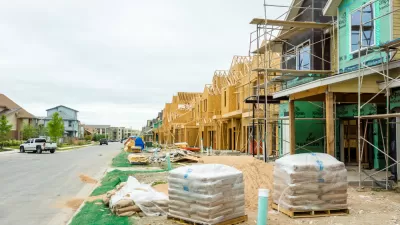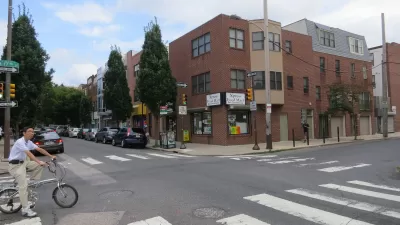A report released this week by the U.S. EPA finds that 71 percent of the country's large metro regions saw an increase in the development of infill housing over the latter half of the last decade. Greenfield development still dominates, however.
The good news in the Environmental Protection Agency's newly released report, "Residential Construction Trends in America's Metropolitan Regions: 2012 Edition" (PDF), is that "infill has become a significant portion of the U.S. housing market." In a press release accompanying the publication of the report, the EPA noted that, "[f]or example, eight out of ten new homes in San Jose, Calif. were infill. New York, Los Angeles, and San Francisco all saw a majority of new home construction in previously developed areas during the same time period."
The bad news? That significant portion accounts for only 21 percent of new home construction, meaning the remaining 79 percent "was built on undeveloped land outside existing communities." Furthermore, finds the report, "[n]early all metropolitan regions are growing outward more than they are growing inward."
Why should we be building more infill? As the EPA notes, "this type of development provides economic and public health benefits to metropolitan areas while protecting the local environment...Infill housing has also been shown to help raise property values, increase a community’s tax base, and attract retail businesses to serve the larger residential population."
FULL STORY: EPA Study Reveals Shift in Housing Developments Across the U.S.

Study: Maui’s Plan to Convert Vacation Rentals to Long-Term Housing Could Cause Nearly $1 Billion Economic Loss
The plan would reduce visitor accommodation by 25,% resulting in 1,900 jobs lost.

North Texas Transit Leaders Tout Benefits of TOD for Growing Region
At a summit focused on transit-oriented development, policymakers discussed how North Texas’ expanded light rail system can serve as a tool for economic growth.

Why Should We Subsidize Public Transportation?
Many public transit agencies face financial stress due to rising costs, declining fare revenue, and declining subsidies. Transit advocates must provide a strong business case for increasing public transit funding.

A Visual Celebration of Manhattan’s Chinatown Elder Community, Through Food
Lanterns, cafeteria trays, and community connection take center stage in this stunning photo essay.

How to Make US Trains Faster
Changes to boarding platforms and a switch to electric trains could improve U.S. passenger rail service without the added cost of high-speed rail.

Columbia’s Revitalized ‘Loop’ Is a Hub for Local Entrepreneurs
A focus on small businesses is helping a commercial corridor in Columbia, Missouri thrive.
Urban Design for Planners 1: Software Tools
This six-course series explores essential urban design concepts using open source software and equips planners with the tools they need to participate fully in the urban design process.
Planning for Universal Design
Learn the tools for implementing Universal Design in planning regulations.
City of Santa Clarita
Ascent Environmental
Institute for Housing and Urban Development Studies (IHS)
City of Grandview
Harvard GSD Executive Education
Toledo-Lucas County Plan Commissions
Salt Lake City
NYU Wagner Graduate School of Public Service




























